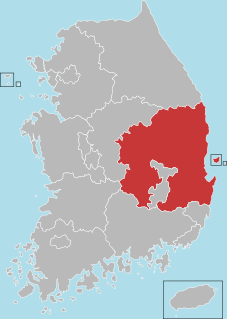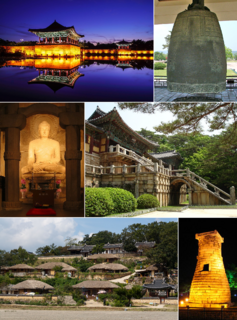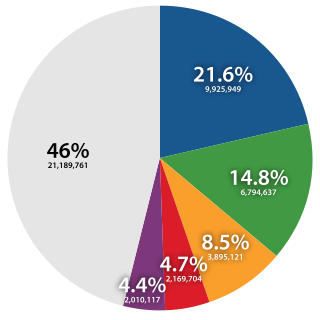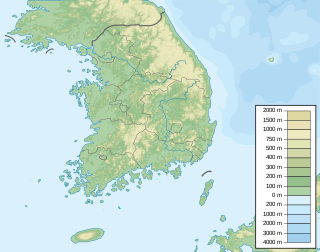
North Gyeongsang Province, also known as Gyeongbuk, is a province in eastern South Korea. The province was formed in 1896 from the northern half of the former Gyeongsang province, and remained a province of Korea until the country's division in 1945, then became part of South Korea.

Silla was a kingdom located in southern and central parts of the Korean Peninsula. Silla, along with Baekje and Goguryeo, formed the Three Kingdoms of Korea.

Gyeongju, historically known as Seorabeol, is a coastal city in the far southeastern corner of North Gyeongsang Province in South Korea. It is the second largest city by area in the province after Andong, covering 1,324 km2 (511 sq mi) with a population of 264,091 people Gyeongju is 370 km (230 mi) southeast of Seoul, and 55 km (34 mi) east of Daegu. The city borders Cheongdo and Yeongcheon to the west, Ulsan to the south and Pohang to the north, while to the east lies the coast of the [[East Sea (Korea)|East Sea ]. Numerous low mountains—outliers of the Taebaek range—are scattered around the city.

The tradition of Korean jade carving dates back to neolithic finds along the Namgang river basin in Gyeongju. Jade rings and accessories were worn by the higher classes of society, especially women, from the three kingdoms period and reached their peak in the Joseon dynasty, the golden age of jadework. Korean jadework often includes buddhist motifs, cicadas, and peanut-shaped good luck talismans on the small scale, as well as larger-scale architectural pieces.
The primary subdivisions of Gyeongju in South Korea consist of 4 eup, 8 myeon, and 11 dong. These units are the same into which all of the cities and counties of South Korea are divided. The dong units occupy the area of the city center, which was formerly occupied by Gyeongju-eup. Eup refers to a substantial village, whereas the myeon are more rural. The current divisions are as follows, using the numbers given on the map:

The Gyeongju National Museum is a museum in Gyeongju, North Gyeongsang Province, South Korea. Its holdings are largely devoted to relics of the Silla kingdom, of which Gyeongju was the capital.

Beopju is a type of cheongju. The name literally means "law liquor", as it is made following a fixed procedure. On 1 November 1986, a variety called Gyodong-beopju was designated by the government of South Korea as Intangible Cultural Property.

Choi is a common Korean family name. As of the South Korean census of 2015, there were 2,333,927 people by this name in South Korea or roughly 4.7% of the population. In English-speaking countries, it is most often anglicized Choi, and sometimes also Choe or Chwe. Ethnic Koreans in the former USSR prefer the form Tsoi (Tsoy) especially as a transcription of the Cyrillic Цой.
Tourism in Gyeongju is a major industry and defining feature of Gyeongju, South Korea. Gyeongju is a major cultural site and tourist destination for South Koreans and foreigners with about 8 to 9 million visitors annually. A great deal of this is due to the city's status as a center of Silla heritage, derived from its former role as the capital of that ancient kingdom.

Hwangnam bread, also commonly called Gyeongju bread, is a local specialty of Gyeongju City, South Korea. It is a small pastry with a filling of red bean paste. Gyeongju bread was first baked in 1939 at a bakery in Hwangnam-dong in central Gyeongju.

Yangdong Folk Village is a traditional yangban village from the Joseon dynasty. The village is located in Gangdong-myeon, sixteen kilometers northeast of Gyeongju, Gyeongsangbuk-do, South Korea, along the Hyeongsan River. Mt. Seolchang stands to the north of the village. The village is designated as Important Folklore Materials No. 189 by the South Korean government.

Gyeongju Korea Hydro & Nuclear Power FC are a South Korean football team based in Gyeongju. They currently compete in the K3 League. They are run by Korea Hydro & Nuclear Power, and play their home games at Gyeongju Civic Stadium.

Gangdong-myeon is a myeon or a township of Gyeongju city in North Gyeongsang Province, South Korea. It is bordered by Pohang on the east and north, Cheonbuk-myeon on the south and Angang-eup on the west. In 2006 its population was 8,705 people, and its area is approximately 81.48 sq kilometers. Its name means "east of the river" although in fact much of it lies north of the Hyeongsan River.

The Gyeongju Seokbinggo is a seokbinggo or ice house located in the neighborhood of Inwang-dong, Gyeongju, North Gyeongsang province, South Korea. It literally means "stone ice storage" in Korean.

Dongcheon-dong is both an administrative and legal dong or a neighbourhood of the Gyeongju City, North Gyeongsang province, South Korea. It is bordered by Bodeok-dong on the east, Yonggang-dong and Seongdong-dong on the west, Bohwang-dong on the south and Cheonbuk-myeon on the north. Its 5.26 square kilometers are home to about 26,507 people. After the liberation of Korea, returnees from abroad were numerous; a village for them was constructed in present-day Dongcheon-dong

Silla Arts and Science Museum is a private history and science museum located in the district of Gyeongju Folk Craft Village, Ha-dong, Gyeongju, North Gyeongsang, South Korea. It was established on 15, October, 1988 by Seok U-il (昔宇一) to provide an opportunity that children and youths visiting Gyeongju could know the root of Korean science. The museum in housed in a two-story building with a basement and consists of six exhibition halls according to theme. The first exhibition room located on the first floor presents a total of seven subjects while the second exhibition room located on the basement displays models of Seokguram grotto, one of representative tangible cultural properties of Gyeongju. The third exhibition room on the west part of the second floor exhibits a model of the bronze bell at Sangwonsa temple in the real size and presents information of bell-making process.
Gyo-dong is a dong or neighborhood in the city of Gyeongju, North Gyeongsang province, South Korea. It is one of legal dong under its administrative dong, Wolseong-dong's jurisdiction. The name, Gyo-dong originates from the fact that the area has had a hyanggyo, government-managed Confucian academies during the Goryeo and Joseon dynasties. It belonged to Bunae-myeon, Gyeongju County (Gyeongju-gun) during the late period of the Joseon Dynasty. Gyo-dong was variously called Hyanggyotgol, Gyochon or Gyori at the times.
Daegu-Gyeongbuk or Taegu-Kyŏngbuk is the compound word of Daegu and Gyeongbuk, and indicates both administrative regions in South Korea. The region usually forms the similar political, economic, and cultural area. Daegu is an independent city from Gyeongsangbuk-do and has the same administrative status with its mother province. Both have their separate local governments reporting directly to the national government.
The 2018 WK League season was the 10th season of the WK League, the top division of women's football in South Korea.

















